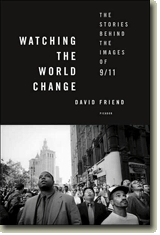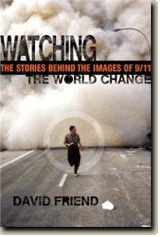February 2009 Archives
« Previous · Home · Next »
February 15, 2009
DIGITAL OVERDOSE
Talk about a digital overdose. This week I served on the jury of the World Press Photo contest. (A gallery of winning images can be found at THIS LINK.) The team of nine judges spent seven days, 12 hours a day, in a closed room in Amsterdam, combing through tens of thousands of photographs - splashed on a screen via digital projector - to come up with the final frame designated as World Press Photo of the Year, shown here.

One of the chief challenges the jury faced was grappling with our ever-evolving and sometimes divergent aesthetics in the age of digital photography. I found the process thoroughly engaging, thanks to the elaborate support system created by the World Press Photo staff and to the talents, diversity, and good-natured spirit of everyone on the jury. Among the biggest surprises was both the sheer quantity (96,000 photographs) and high-quality of the work from nations such as China, India, and Poland.
RITCHIN’S NEW BOOK
Most evenings, after each exhausting round of judging, I returned to my hotel room to dip into a particularly apt book, Fred Ritchin’s new Norton publication, After Photography, which I found penetratingly perceptive.

Since its 19th century inception, we have considered photography to be, quite literally, picture-taking: the grabbing of a slice of reality that was a rather faithful documentation of a single moment in time and space. Photography, however, has never been objective. It is, as I argue in Watching the World Change, a subjective medium, as all art forms are.
(Pages 224-5) “We trust pictures. We are neurologically comfortable with what we can see. Even in this era of computer-manipulated imagery, in which we are duped every day by the transmogrification afforded by Photoshop, even as we wholeheartedly acknowledge that pictures are subjective representations – biased by the particularities of film stock, camera type, lens length, and shutter speed; by the method of printing or displaying the finished image; by the aesthetic or journalistic ‘perspective’ of the photographer – we tend to trust what we see within the boundaries of the photographic frame, appearances notwithstanding.” Even the most egregiously Photoshopped images convey, at their essence, a kernel of truth.
Fred Ritchin, in discussing the perils and opportunities that the digital revolution has brought to photography, spends a lot of time in After Photography examining the “paradoxical credibility” of photographs (p. 19) in what might be called the post-photographic age. A photograph, he says, maintains the “background duality of its surviving role as [a] direct trace [of reality],” but it is actually more interpretive and more amorphous – “a less proximate signifier, like words, paintings, or drawings.” (p. 31) “Photographs,” Ritchin writes, “can be thought of, like writing, as nonfictional and fictional (which is not at all the same as analog and digital). Fact-based, respecting context, carefully captioned, these ‘nonfictional’ photographs, while always interpretive, can establish the existence of a visible reality for the duration of a fractional second. In certain cases they may be able to do no more than that. But the mechanical-age capacity for recording the visible may have to be guarded dearly in a chaotic world where clashing and often unyielding points of view make it difficult to agree on the most pivotal of facts. Rather than at the end of a gun, it makes sense for the photograph to continue to be one arbitrator of what actually happened.” (p. 66-7).
Ritchin, by way of contrast, then goes on to quote filmmaker Wim Wenders (from a 1996 essay, “Photography After Photography,” by Jacques Clayssen): “The digitized picture has broken the relationship between picture and reality once and for all. We are entering an era when no one will be able to say whether a picture is true or false. They are all becoming beautiful and extraordinary, and with each passing day they belong increasingly to the world of advertising. Their beauty, like their truth, is slipping away from us. Soon, they will really end up making us blind.”
On the subject of 9/11, about which Ritchin has written elsewhere, he discusses how “the hijackers…also hijacked the visual language of Hollywood, using the imagery of action films that the United States had exported throughout the world.” (p. 79)
On comparing quantum mechanics and digital-age photography, he is especially astute, talking about how new photography, like the so-called New Physics, treats light as both a particle and a wave. “The digital-quantum photograph reinstates some of the uncertainty that surrounded the first photographs. It’s not that the photograph ‘never lies,’ but that in some ways it always does….
“Image cannot be calcified from a quantum photograph when it is indeterminacy, not instant credibility, that is evoked….
“The photography of the future can explore and delineate universes where multiple principles are at work, and where existence is both solid and illusory…. Photography will not so much stop or capture time as acknowledge its space-time plasticity.” (p. 181)
I heartily recommend After Photography.
…AND TO READ MORE about the World Press Photo contest, here is a thorough piece from the British Journal of Photography.
...COFFINS AND CAMERAS. In today's Times, Katharine Q. Seelye reports on the Obama Administration's reassessment of the Pentagon's policy of not allowing press photographers to document the arrival on U.S. soil of the coffins bearing the remains of soldiers killed in Iraq and Afghanistan.
...BY THE WAY...This marks my 200th posting on this blog. My thanks to every eyeball that has strayed to this page.
February 1, 2009
AT LAST
At last comes definitive word that the World Trade Center Memorial will be officially inaugurated, though not completed, by 2011, in time for the tenth anniversary of the attacks.


